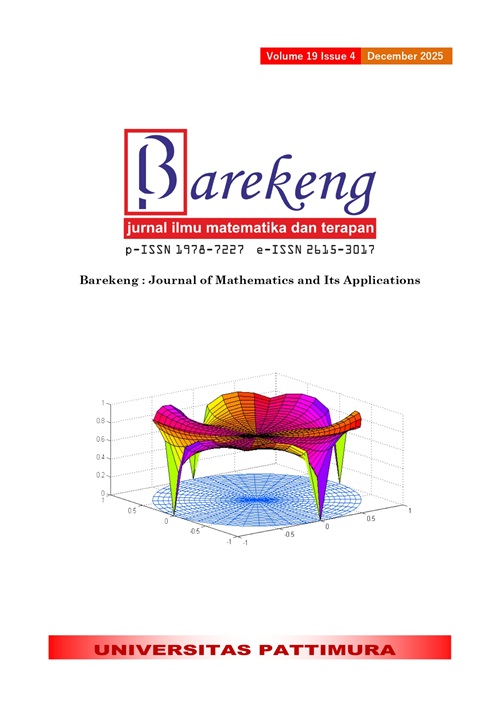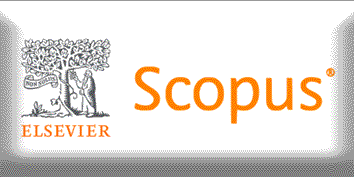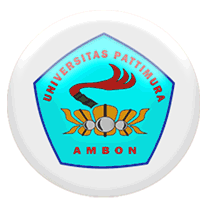PARTICLE SWARM OPTIMIZATION FOR CUTTING ALUMINUM STOCK AND ITS COMPARISON WITH THE EXACT METHOD
Abstract
The Cutting Stock Problem (CSP) is a common challenge in many industries, involving the optimization of material cutting to minimize waste while meeting customer demands. Various methods can be used to address this issue. This paper applies the heuristic Particle Swarm Optimization (PSO) method to solve CSP in the case of one-dimensional aluminum roll cutting. First, we identify feasible cutting pattern combinations. A mathematical model and constraints are then formulated based on these patterns. Next, the PSO algorithm is employed to determine the optimal combination of cutting patterns, minimizing material waste. The results yield the optimal aluminum roller cutting pattern. Furthermore, we compare the results between the PSO method and the exact method.
Downloads
References
D. Tanir, O. Ugurlu, A. Guler, and U. Nuriyev, “ONE-DIMENSIONAL CUTTING STOCK PROBLEM WITH DIVISIBLE ITEMS: A CASE STUDY IN STEEL INDUSTRY,” Turkish World Mathematical Society Journal of Applied and Engineering Mathematics, vol. 9, no. 3, pp. 473–484, 2019.
B. P. Silalahi, F. Hanum, F. Setyawan, and P. T. Supriyo, “ONE-DIMENSIONAL CUTTING STOCK PROBLEM THAT MINIMIZES THE NUMBER OF DIFFERENT PATTERNS,” BAREKENG: Jurnal Ilmu Matematika dan Terapan, vol. 16, no. 3, 2022, doi: https://doi.org/10.30598/barekengvol16iss3pp805-814
O. Ayadi, M. Masmoudi, M. Ben Ameur, and F. Masmoudi, “A NEW PSO-BASED ALGORITHM FOR TWO-DIMENSIONAL NON-GUILLOTINE NON-ORIENTED CUTTING STOCK PROBLEM,” Applied Artificial Intelligence, vol. 31, no. 4, pp. 376–393, 2017, doi: https://doi.org/10.1080/08839514.2017.1346966.
F. Clautiaux, R. Sadykov, F. Vanderbeck, and Q. Viaud, “PATTERN-BASED DIVING HEURISTICS FOR A TWO-DIMENSIONAL GUILLOTINE CUTTING-STOCK PROBLEM WITH LEFTOVERS,” EURO Journal on Computational Optimization, vol. 7, no. 3, 2019, doi: https://doi.org/10.1007/s13675-019-00113-9 .
M. Atika, B. P. Silalahi, and F. Bukhari, “PATTERN GENERATION FOR THREE DIMENSIONAL CUTTING STOCK PROBLEM,” JTAM (Jurnal Teori dan Aplikasi Matematika), vol. 6, no. 4, 2022, doi: https://doi.org/10.31764/jtam.v6i4.9933.
P. C. Gilmore and R. E. Gomory, “A LINEAR PROGRAMMING APPROACH TO THE CUTTING STOCK PROBLEM—PART II,” Oper Res, vol. 11, no. 6, 1963, doi: https://doi.org/10.1287/opre.11.6.863.
P. C. Gilmore and R. E. Gomory, “A LINEAR PROGRAMMING APPROACH TO THE CUTTING-STOCK PROBLEM,” Oper Res, vol. 9, no. 6, 1961, doi: https://doi.org/10.1287/opre.9.6.849.
S. A. de Araujo, K. C. Poldi, and J. Smith, “A GENETIC ALGORITHM FOR THE ONE-DIMENSIONAL CUTTING STOCK PROBLEM WITH SETUPS,” Pesquisa Operacional, vol. 34, no. 2, 2014, doi: ttps://doi.org/10.1590/0101-7438.2014.034.02.0165.
Bambang Santoso and Heri Haerudin, “GENETIC ALGORITHM APPROACH FOR CUTTING STOCK PROBLEMS IN CONSTRUCTION INDUSTRIES,” International Journal of Integrative Sciences, vol. 2, no. 7, 2023, doi: https://doi.org/10.55927/ijis.v2i7.4810.
A. R. Botsali and K. Alaykiran, “ANALYSIS OF TSP: SIMULATED ANNEALING AND GENETIC ALGORITHM APPROACHES,” International Journal of Computational and Experimental Science and Engineering, vol. 6, no. 1, 2020, doi: https://doi.org/10.22399/ijcesen.637445.
Z. Zheng and Y. Li, “AUTOMATED BOARDING LAYOUT AND WASTE OPTIMIZATION FOR EXTERIOR WALLS USING SIMULATED ANNEALING ALGORITHM,” in Mechanisms and Machine Science, 2024. doi: https://doi.org/10.1007/978-3-031-44947-5_58.
T. M. Shami, A. A. El-Saleh, M. Alswaitti, Q. Al-Tashi, M. A. Summakieh, and S. Mirjalili, “PARTICLE SWARM OPTIMIZATION: A COMPREHENSIVE SURVEY,” IEEE Access, vol. 10, 2022, doi: https://doi.org/10.1109/ACCESS.2022.3142859.
K. Ren, L. Jia, J. Huang, and M. Wu, “RESEARCH ON CUTTING STOCK OPTIMIZATION OF REBAR ENGINEERING BASED ON BUILDING INFORMATION MODELING AND AN IMPROVED PARTICLE SWARM OPTIMIZATION ALGORITHM,” Developments in the Built Environment, vol. 13, 2023, doi: https://doi.org/10.1016/j.dibe.2023.100121.
R. Eberhart and J. Kennedy, “NEW OPTIMIZER USING PARTICLE SWARM THEORY,” in Proceedings of the International Symposium on Micro Machine and Human Science, 1995. doi: 10.1109/mhs.1995.494215.
N. Franken and A. P. Engelbrecht, “PARTICLE SWARM OPTIMIZATION APPROACHES TO COEVOLVE STRATEGIES FOR THE ITERATED PRISONER’S DILEMMA,” IEEE Transactions on Evolutionary Computation, vol. 9, no. 6, 2005, doi: https://doi.org/10.1109/TEVC.2005.856202.
G. Ben Lagha, N. Dahmani, and S. Krichen, “PARTICLE SWARM OPTIMIZATION APPROACH FOR RESOLVING THE CUTTING STOCK PROBLEM,” in 2014 International Conference on Advanced Logistics and Transport, ICALT 2014, 2014. doi: https://doi.org/10.1109/ICAdLT.2014.6866321.
B. P. Silalahi, K. Fatihin, P. T. Supriyo, and S. Guritman, “ALGORITME SWEEP DAN PARTICLE SWARM OPTIMIZATION DALAM OPTIMISASI RUTE KENDARAAN DENGAN KAPASITAS,” Jurnal Matematika Integratif, vol. 16, no. 1, p. 29, Apr. 2020, doi: https://doi.org/10.24198/jmi.v16.n1.27474.29-40.
B. P. Silalahi, M. Novanto, and P. T. Supriyo, “ALGORITME MIGRATING BIRDS OPTIMIZATION DAN ALGORITME PARTICLE SWARM OPTIMIZATION: PENYELESAIAN MASALAH KNAPSACK 0-1,” PYTHAGORAS Jurnal Pendidikan Matematika, vol. 17, no. 1, 2022, doi: https://doi.org/10.21831/pythagoras.v17i1.35660.
F. Yunita, Pranowo, and A. J. Santoso, “HYBRID MODEL OF PARTICLE SWARM AND ANT COLONY OPTIMIZATION IN LECTURE SCHEDULE PREPARATION,” in AIP Conference Proceedings, 2018. doi: https://doi.org/10.1063/1.5042895.
M. Clerc and J. Kennedy, “THE PARTICLE SWARM-EXPLOSION, STABILITY, AND CONVERGENCE IN A MULTIDIMENSIONAL COMPLEX SPACE,” IEEE Transactions on Evolutionary Computation, vol. 6, no. 1, 2002, doi: https://doi.org/10.1109/4235.985692.
I. C. Trelea, “THE PARTICLE SWARM OPTIMIZATION ALGORITHM: CONVERGENCE ANALYSIS AND PARAMETER SELECTION,” Inf Process Lett, vol. 85, no. 6, 2003, doi: https://doi.org/10.1016/S0020-0190(02)00447-7.
V. Kadirkamanathan, K. Selvarajah, and P. J. Fleming, “STABILITY ANALYSIS OF THE PARTICLE DYNAMICS IN PARTICLE SWARM OPTIMIZER,” IEEE Transactions on Evolutionary Computation, vol. 10, no. 3, 2006, doi: https://doi.org/10.1109/TEVC.2005.857077.
F. Van Den Bergh and A. P. Engelbrecht, “A STUDY OF PARTICLE SWARM OPTIMIZATION PARTICLE TRAJECTORIES,” Inf Sci (N Y), vol. 176, no. 8, 2006, doi: https://doi.org/10.1016/j.ins.2005.02.003.
R. A. Krohling and L. Dos Santos Coelho, “COEVOLUTIONARY PARTICLE SWARM OPTIMIZATION USING GAUSSIAN DISTRIBUTION FOR SOLVING CONSTRAINED OPTIMIZATION PROBLEMS,” IEEE Transactions on Systems, Man, and Cybernetics, Part B: Cybernetics, vol. 36, no. 6, 2006, doi: https://doi.org/10.1109/TSMCB.2006.873185.
B. Liu, L. Wang, and Y. H. Jin, “AN EFFECTIVE PSO-BASED MEMETIC ALGORITHM FOR FLOW SHOP SCHEDULING,” IEEE Transactions on Systems, Man, and Cybernetics, Part B: Cybernetics, vol. 37, no. 1, 2007, doi: https://doi.org/10.1109/TSMCB.2006.883272.
M. Nabab, “PARTICLE SWARM OPTIMIZATION: ALGORITHM AND ITS CODES IN MATLAB,” ResearchGate, no. 1, 2016.
S. M. A. Suliman, “PATTERN GENERATING PROCEDURE FOR THE CUTTING STOCK PROBLEM,” Int J Prod Econ, vol. 74, no. 1–3, 2001, doi: https://doi.org/10.1016/S0925-5273(01)00134-7.
S. Octarina, P. B. J. Bangun, and M. Avifana, “REDUKSI POLA PEMOTONGAN KERTAS PADA CUTTING STOCK PROBLEM ( CSP ) SATU DIMENSI,” Prosiding Annual Research Seminar 2016, vol. 2, no. 1, 2016.
Copyright (c) 2025 Bib Paruhum Silalahi, Siti Aminah, Hidayatul Mayyani, Amril Aman

This work is licensed under a Creative Commons Attribution-ShareAlike 4.0 International License.
Authors who publish with this Journal agree to the following terms:
- Author retain copyright and grant the journal right of first publication with the work simultaneously licensed under a creative commons attribution license that allow others to share the work within an acknowledgement of the work’s authorship and initial publication of this journal.
- Authors are able to enter into separate, additional contractual arrangement for the non-exclusive distribution of the journal’s published version of the work (e.g. acknowledgement of its initial publication in this journal).
- Authors are permitted and encouraged to post their work online (e.g. in institutional repositories or on their websites) prior to and during the submission process, as it can lead to productive exchanges, as well as earlier and greater citation of published works.






1.gif)



